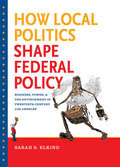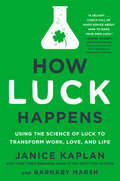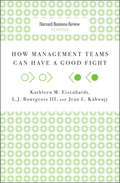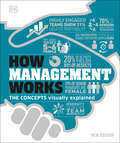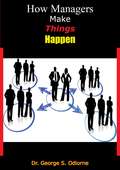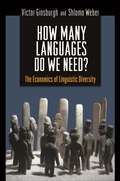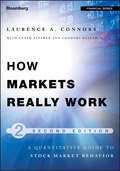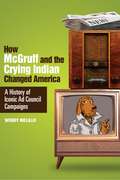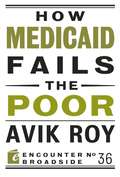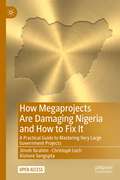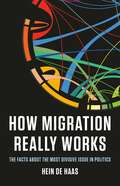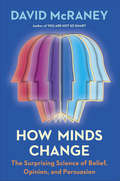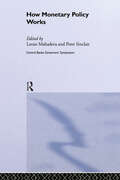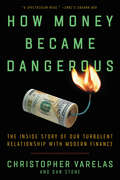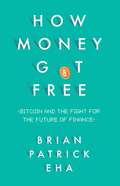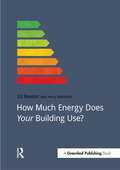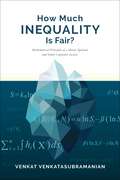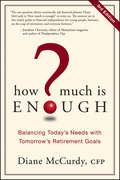- Table View
- List View
How Local Politics Shape Federal Policy
by Sarah S. ElkindFocusing on five Los Angeles environmental policy debates between 1920 and 1950, Sarah Elkind investigates how practices in American municipal government gave business groups political legitimacy at the local level as well as unanticipated influence over federal politics. Los Angeles's struggles with oil drilling, air pollution, flooding, and water and power supplies expose the clout business has had over government. Revealing the huge disparities between big business groups and individual community members in power, influence, and the ability to participate in policy debates, Elkind shows that business groups secured their political power by providing Los Angeles authorities with much-needed services, including studying emerging problems and framing public debates. As a result, government officials came to view business interests as the public interest. When federal agencies looked to local powerbrokers for project ideas and political support, local business interests influenced federal policy, too. Los Angeles, with its many environmental problems and its dependence upon the federal government, provides a distillation of national urban trends, Elkind argues, and is thus an ideal jumping-off point for understanding environmental politics and the power of business in the middle of the twentieth century.
How Luck Happens: Using the Science of Luck to Transform Work, Love, and Life
by Janice Kaplan Barnaby MarshNew York Times bestselling author Janice Kaplan examines the phenomenon of luck--and discovers the exciting ways you can grab opportunities and make luck for yourself every day. After spending a year researching and experiencing gratitude for The Gratitude Diaries, Janice Kaplan is back to tackle another big, mysterious influence in all our lives: luck. And this time she's joined on her journey by coauthor Dr. Barnaby Marsh, a renowned academic who guides her exploration. Together they uncover the unexpected, little-understood science behind what we call "luck," proving that many seemingly random events are actually under your--and everyone's--control. They examine the factors that made stars like Harrison Ford and Jonathan Groff so successful, and learn the real secrets that made Kate Spade and Warby Parker into global brands. Using original research, fascinating studies, and engaging interviews, Kaplan and Marsh reveal the simple techniques to create luck in love and marriage, business and career, and health, happiness, and family relationships. Their breakthrough insights prove that all of us--from CEOs to stay-at-home moms--can tip the scales of fortune in our favor. Through a mix of scientific research, conversations with famous and successful people--from academics like Dan Ariely and Leonard Mlodinow to actor Josh Groban--and powerful narrative, How Luck Happens uncovers a fascinating subject in accessible and entertaining style.
How MNCs Cope with Host Government Intervention
by C. K. Prahalad Yves L. DozThe efforts of host governments to maintain control over their own national economies have restricted the freedom of multinational company (MNC) managers in deploying economic resources. Regulation interferes with product/market choice, use of technology, level of employment, and national trade balance. Compromise is an alternative to the choices of adaptation to or withdrawal from a national market.
How Management Teams Can Have a Good Fight
by Kathleen M. Eisenhardt Jean L. Kahwajy L. J. Bourgeois IIIConflict in the workplace is natural-and even necessary. Colleagues who challenge one another's thinking tend to consider a richer range of options, which ultimately leads to better business decisions. How Management Teams Can Have a Good Fight reveals the tactics managers can use to ensure that these healthy back-and-forth moments remain constructive and focused on the issues. Managers who embrace this kind of positive conflict will find increasingly engaged, productive teams-and discover that they themselves are better positioned to lead these teams to success. Since 1922, Harvard Business Review has been a leading source of breakthrough ideas in management practice. The Harvard Business Review Classics series now offers you the opportunity to make these seminal pieces a part of your permanent management library. Each highly readable volume contains a groundbreaking idea that continues to shape best practices and inspire countless managers around the world.
How Management Teams Can Have a Good Fight (HBR Bestseller)
by Kathleen M. Eisenhardt L. J. Bourgeois Jean L. KahwajyTop level managers know that conflict over issues is natural and even necessary. Management teams that challenge one another's thinking develop a more complete understanding of their choices, create a richer range of options, and make better decisions. But the challenge--familiar to anyone who has ever been part of a management team--is to keep constructive conflict over issues from degenerating into interpersonal conflict. From their research on the interplay of conflict, politics, and speed in the decision-making process of management teams, the authors have distilled a set of tactics characteristic of high-performing teams. These tactics work because they keep conflict focused on issues; foster collaborative, rather than competitive, relations among team members; and create a sense of fairness in the decision-making process.
How Management Works: The Concepts Visually Explained (DK How Stuff Works)
by DKDiscover everything you need to know to improve your management skills, and understand key management and business theories with this unique graphic guide.Combining clear, jargon-free language and bold, eye-catching graphics, How Management Works is a definitive and user-friendly guide to all aspects of organizational management. Learn whether it is more effective to lead through influence or control? Is delegation the key to productivity and how do you deal with different personalities? Drawing on the latest theories and practices - and packed with graphics and diagrams that demystify complex management concepts - this book explains everything you need to know to build your management skills and get the very best out of your team. It is essential reading if you are an established or aspiring manager, or are studying a course in business or management. Much more than a standard business-management or self-help book, How Management Works shows you what other titles only tell you, combining solid reference with no-nonsense advice. It is the perfect primer for anyone looking to start their own business, become a more effective leader, or simply learn more about the world of business and management.
How Managers Make Things Happen
by Dr George S. OdiorneHow can a manager control business situations to make them work for, rather than against him?Dropping the “soft approach to human relations,” the author of this book, first published in 1961, strikes out for compelling leadership. He teaches managers how to make things happen and get things done. He reveals methods not usually discussed in “how to” books, and seldom taught in the schools of business.Dr. Odiorne’s ideas have been called “fresh and striking,” and his concepts of the executive as a manager of situations have been labeled “valid and provocative.”His incidents, as depicted herein, are carbon copies of those actually existing in business today. And it has been said that Odiorne accurately molds the type of manager “I would like to work for.”Gain fuller cooperation, sharpen training, and generate greater productivity with these compelling tactics that spark subordinates to action and get things done.
How Many Languages Do We Need?: The Economics of Linguistic Diversity
by Victor Ginsburgh Shiomo WeberIn the global economy, linguistic diversity influences economic and political development as well as public policies in positive and negative ways. It leads to financial costs, communication barriers, divisions in national unity, and, in some extreme cases, conflicts and war--but it also produces benefits related to group and individual identity. What are the specific advantages and disadvantages of linguistic diversity and how does it influence social and economic progress? This book examines linguistic diversity as a global social phenomenon and considers what degree of linguistic variety might result in the greatest economic good. Victor Ginsburgh and Shlomo Weber look at linguistic proximity between groups and between languages. They describe and use simple economic, linguistic, and statistical tools to measure diversity's impact on growth, development, trade, the quality of institutions, translation issues, voting patterns in multinational competitions, and the likelihood and intensity of civil conflicts. They address the choosing of core languages in a multilingual community, such as the European Union, and argue that although too many official languages might harm cohesiveness, efficiency, and communication, reducing their number brings about alienation and disenfranchisement of groups. Demonstrating that the value and drawbacks of linguistic diversity are universal, How Many Languages Do We Need? suggests ways for designing appropriate linguistic policies for today's multilingual world.
How Markets Really Work: Quantitative Guide to Stock Market Behavior (Bloomberg Financial #158)
by Larry ConnorsFor years, traders and investors have been using unproven assumptions about popular patterns such as breakouts, momentum, new highs, new lows, market breadth, put/call ratios and more without knowing if there is a statistical edge. Common wisdom holds that the stock markets are ever changing. But, as it turns out, common wisdom can be wrong. Offering a comprehensive look back at the way the markets have acted over the last two decades, How Markets Really Work: A Quantitative Guide to Stock Market Behavior, Second Edition shows that nothing has changed, that the markets behave the same way today as they have in years past, and that understanding this puts you in a prime position to profit. Written by two top financial experts and filled with charts and graphs that illustrate the market concepts they develop, the book takes a sometimes contrarian view of everything from market edges to historical volatility, and from volume to put/call ratio, giving you all that you need to truly understand how the markets function. Fully revised and updated, How Markets Really Work, Second Edition takes a level-headed, data-driven look at the markets to show how they function and how you can apply that information intelligently when making investment decisions.
How Markets and Industries Affect Project Management
by Aaron J. Shenhar Dov DvirThis chapter explores how various kinds of customers and markets require various project management styles, and outlines the differences in project management among major industries.
How McGruff and the Crying Indian Changed America: A History of Iconic Ad Council Campaigns
by Wendy MelilloHow McGruff and the Crying Indian Changed America: A History of Iconic Ad Council Campaigns details how public service advertising campaigns became part of our national conversation and changed us as a society. The Ad Council began during World War II as a propaganda arm of President Roosevelt's administration to preserve its business interests. Happily for the ad industry, it was a double play: the government got top-notch work; the industry got an insider relationship that proved useful when warding off regulation. From Rosie the Riveter to Smokey Bear to McGruff the Crime Dog, How McGruff and the Crying Indian Changed America explores the issues and campaigns that have been paramount to the nation's collective memory and looks at challenges facing public service campaigns in the current media environment.
How Media Choices are Changing Online Advertising
by Stephen P. Bradley Nancy BartlettWhat is the response by advertisers as media consumption moves to the digital medium? Provides an overview of online advertising in mid-2006 and discusses the impact of an increasingly fractured media landscape and its accompanying expanding advertising options.
How Medicaid Fails the Poor
by Avik RoyMedicaid, America's government-run health insurance program for the poor, should be a lifeline that provides needed health care to Americans with no other options. Surprisingly, however, it doesn't. The medical literature reveals a $450 billion-a-year scandal: that people on Medicaid have far worse health outcomes than those with private insurance, and no better outcomes than those with no insurance at all.Why is this so? In How Medicaid Fails the Poor, Avik Roy explains how Medicaid's clumsy design and perverse incentives make it hard for people on Medicaid to get the medical care they need. Medicaid doesn't reimburse doctors or hospitals for the cost of caring for Medicaid enrollees, forcing many doctors to opt out of the program.The Affordable Care Act, otherwise known as Obamacare, doubles down on this broken system. Roy shows us that there are better ways, using private insurance, to provide needed care to our poorest citizens.
How Megaprojects Are Damaging Nigeria and How to Fix It: A Practical Guide to Mastering Very Large Government Projects
by Christoph Loch Jimoh Ibrahim Kishore SenguptaSince 1960, two-thirds of very large governmental projects in Nigeria have not only failed, but been abandoned mid-course. This presents a bigger failure rate than mega projects elsewhere, and yet there is no available data or analysis to help us understand the reasons behind such failures. This book provides an authoritative examination into why very large projects in Nigeria have failed so badly, and provides practical recommendations on how the Nigerian government can improve its project performance.Drawing on data from 38 very large projects (19 completed and 19 abandoned) with a total budget of over $25B, this book presents detailed analysis of these projects and in-depth case studies 11 of the projects, and presents lessons for improvement. Through this, the authors have identified a small number of key success drivers, and argue that making moderate improvements on any of them would, on average, save hundreds of millions of dollars on one large project alone.This book is a game-changer in the management of government mega projects in Nigeria. With clear implications for other developing economies, this is a vital resource for project management practitioners, executives and civil servants.This is an open access book.
How Migration Really Works: The Facts About the Most Divisive Issue in Politics
by Hein de HaasAn authoritative guide to global migration that corrects decades of misunderstanding and misguided policy, "defying orthodoxy on all sides of the debate" (Yascha Mounk, author of The Identity Trap). As debates on immigration have reached fever pitch, so has political and media fearmongering. But what are the facts behind the headlines? Drawing on three decades of research, migration expert Hein de Haas destroys the myths that politicians, interest groups, and media spread about immigration. He reveals: Global migration is not at an all-time high Climate change will not lead to mass migration Immigration mainly benefits the wealthy, not workers Border restrictions have paradoxically produced more migration Ultimately, de Haas shows migration not as a problem to be solved, nor as a solution to a problem, but as it really is. This book is an essential guide to one of our most divisive political issues, showing how we can move beyond today&’s deeply polarized debate and make migration work better for everyone.
How Minds Change: The Surprising Science of Belief, Opinion, and Persuasion
by David McRaneyA brain-bending investigation of why some people never change their minds—and others do in an instant—by the bestselling author of You Are Not So SmartWhat made a prominent conspiracy-theorist YouTuber finally see that 9/11 was not a hoax? How do voter opinions shift from neutral to resolute? Can widespread social change only take place when a generation dies out? From one of our greatest thinkers on reasoning, HOW MINDS CHANGE is a book about the science, and the experience, of transformation. When self-delusion expert and psychology nerd David McRaney began a book about how to change someone&’s mind in one conversation, he never expected to change his own. But then a diehard 9/11 Truther&’s conversion blew up his theories—inspiring him to ask not just how to persuade, but why we believe, from the eye of the beholder. Delving into the latest research of psychologists and neuroscientists, HOW MINDS CHANGE explores the limits of reasoning, the power of groupthink, and the effects of deep canvassing. Told with McRaney&’s trademark sense of humor, compassion, and scientific curiosity, it&’s an eye-opening journey among cult members, conspiracy theorists, and political activists, from Westboro Baptist Church picketers to LGBTQ campaigners in California—that ultimately challenges us to question our own motives and beliefs. In an age of dangerous conspiratorial thinking, can we rise to the occasion with empathy? An expansive, big-hearted journalistic narrative, HOW MINDS CHANGE reaches surprising and thought-provoking conclusions, to demonstrate the rare but transformative circumstances under which minds can change.
How Mobil Became a Strategy-Focused Organization
by Robert S. Kaplan David P. NortonBeginning in 1994, Mobil launched its Balanced Scorecard initiative, transforming what had been an underperforming organization that was inwardly focused, bureaucratic, and inefficient into the leader in its industry. This chapter examines the case of Mobil NAM&R, illustrating how putting the five principles of a Strategy-Focused Organization into practice and integrating and aligning the entire organization to a new strategy for growth enabled the company to achieve sustained competitive advantage in a mature and fiercely competitive commodity industry.
How Monetary Policy Works (CENTRAL BANK GOVERNOR'S SYMPOSIUM)
by Peter Sinclair Lavan MahadevaFor monetary policymakers worldwide, developing a practical understanding of how monetary policy transmits to the economy is a day-to-day challenge. The data such policymakers have is imperfect, the maps they use are continually redrawn. With such uncertainty, understanding this complicated issue is rarely straightforward.This book, a collaboration between some of the finest minds working on monetary theory in the world, helps to provide a foundation for understanding monetary policy in all its complex glory. Using models, case studies and new empirical evidence, the contributors to this book help readers on many levels develop their technical expertise.Students of macroeconomics, money and banking and international finance will find this to be a good addition to their reading lists. At the same time, policymakers and professionals within banking will learn valuable lessons from a thorough read of this book's pages.
How Money Became Dangerous: The Inside Story of Our Turbulent Relationship with Modern Finance
by Dan Stone Christopher VarelasFrom a veteran of the trade, a provocative and entertaining voyage into the turbulent heart of modern money that sheds new light on the rise of our threatening and complicated financial system, how money became our adversary, and why finding a new course is crucial to a healthy societyIn the not too distant past, money was simple. You might have had a bank account and a mortgage, perhaps some basic investments. Wall Street didn’t have a reputation for greed and recklessness. That all started to change in the eighties, as our financial systems became increasingly complex, moving beyond the understanding of the general public while impacting our lives in innumerable ways. The financial world began to feel like an enigma—a rogue force working against us, seemingly controlled by no one. From an industry veteran who’s had firsthand involvement in the events that shaped modern money, How Money Became Dangerous journeys from the crime-ridden LA jewelry district to the cutthroat Salomon Brothers trading floor, from the high-stakes world of investment banking to the center of the technology boom, capturing the key deals, developments, and players that made the financial world what it is today. The book illuminates the dark, hidden forces of Wall Street and how it has dehumanized and left behind everyday Americans. A fresh and enlightening take on how we reached this point, How Money Became Dangerous also makes the case for why Wall Street needs to be saved, if only to save ourselves.
How Money Got Free: Bitcoin and the Fight for the Future of Finance
by Brian Patrick EhaIn the space of a few years, Bitcoin has gone from an idea ignored or maligned by almost everyone to an asset with a market cap of more than $12 billion. Venture capital firms, Goldman Sachs, the New York Stock Exchange, and billionaires such as Richard Branson and Peter Thiel have invested more than $1 billion in companies built on this groundbreaking technology. Bill Gates has even declared it &‘better than currency&’. The pioneers of Bitcoin were twenty-first-century outlaws – cryptographers, hackers, Free Staters, ex-cons and drug dealers, teenage futurists and self-taught entrepreneurs – armed with a renegade ideology and a grudge against big government and big banks. Now those same institutions are threatening to co-opt or curtail the impact of digital currency. But the pioneers, some of whom have become millionaires themselves, aren&’t going down without a fight. Sweeping and provocative, How Money Got Free reveals how this disruptive technology is shaping the debate around competing ideas of money and liberty, and what that means for our future.
How Money Works: The Facts Visually Explained (DK How Stuff Works)
by DKIt makes the world go round, but money can truly be an enigma. DK&’s visual approach breaks new ground. In graphics, charts, and diagrams, How Money Works demystifies processes and answers the hundreds of financial questions we all have.Money facilitates the billions of transactions that take place every day across the globe. Using &‘need to know&’ boxes, step-by-step diagrams, and other eye-catching visuals, How Money Works shows you how this is possible. It explains economic theories, how governments raise and control money, what goes on in the stock exchange, how analysts predict where shares are heading, and many other issues. It busts jargon, explaining terms such as quantitative easing, cash flow, bonds, superannuation, and the open market.This must-have guide to money further features:Key financial concepts in a uniquely visual way, using bold infographics combined with simple, jargon-free language. Genuinely comprehensive, covering every aspect of money – personal, business, and governmental. Defines hundreds of money-related terms, such as cash flow, bonds, superannuation, and the open market. Offers essential basic know-how on everything from managing debt to online fraud. Fully up-to-date, covering topics such as cryptocurrencies (Bitcoin, Litecoin, and others) and quantitative easing. Includes localizable appendix of territory specific reference information.Our forefathers may have used simple bartering to exchange goods and services, but today we depend on complicated financial instruments for pensions, life assurance, mortgages, and more. How Money Works explains how these work, as well as how to avoid on-line fraud and where to invest. With information on the latest forms of funding and currencies such as Bitcoin, this comprehensive book will fast track you to financial literacy and getting the most from your hard-won cash.
How Much Energy Does Your Building Use? (Doshorts Ser.)
by Kerry Mashford Liz ReasonWhy do award-winning "green" buildings so often have higher energy bills than ordinary buildings? Why do expensive refurbishments deliver outcomes that are far from the promises of improved sustainability? Why does your building have high running costs and still the occupants complain about being too cold or too hot and are otherwise dissatisfied?The failure of many countries to produce buildings that are comfortable with excellent energy performance is a scandal. Achieving low energy buildings does not involve learning rocket science: just some basic building physics, a clear language for talking meaningfully about energy-efficient outcomes with all those in the buildings cycle, and an outlook that casts a new low energy perspective on old problems. This book provides that common language. It outlines a path towards understanding what makes for a good quality low energy building, the stakeholders that need to be engaged, and encourages new ways of thinking about how to reduce energy use and costs.This book is for everyone in the buildings cycle, from CEOs of major construction companies to Sustainability, Energy, Environment, Facilities and Utilities managers in any company that aims to reduce energy use in a non-domestic building.
How Much Inequality Is Fair?: Mathematical Principles of a Moral, Optimal, and Stable Capitalist Society
by Venkat VenkatasubramanianMany in the United States feel that the nation’s current level of economic inequality is unfair and that capitalism is not working for 90% of the population. Yet some inequality is inevitable. The question is: What level of inequality is fair? Mainstream economics has offered little guidance on fairness and the ideal distribution of income. Political philosophy, meanwhile, has much to say about fairness yet relies on qualitative theories that cannot be verified by empirical data. To address inequality, we need to know what the goal is—and for this, we need a quantitative, testable theory of fairness for free-market capitalism.How Much Inequality Is Fair? synthesizes concepts from economics, political philosophy, game theory, information theory, statistical mechanics, and systems engineering into a mathematical framework for a fair free-market society. The key to this framework is the insight that maximizing fairness means maximizing entropy, which makes it possible to determine the fairest possible level of pay inequality. The framework therefore provides a moral justification for capitalism in mathematical terms. Venkat Venkatasubramanian also compares his theory’s predictions to actual inequality data from various countries—showing, for instance, that Scandinavia has near-ideal fairness, while the United States is markedly unfair—and discusses the theory’s implications for tax policy, social programs, and executive compensation.
How Much Is Enough
by Diane MccurdyThe numerical and emotional aspects of planning for retirementThis hands-on resource demystifies financial planning by giving the Enough number: an exact figure specific to personal goals, which can be a target number to aim for in retirement. It shows what changes will help to achieve the number, and offers an understanding of hidden motivations when it comes to spending money. It also provides an overview of the multitudes of investments available and provides conservative guidelines that will help make money, save taxes, and sleep at night.Offers a clear understanding of the different attitudes toward money and includes strategies to achieve goalsIncludes the tools needed to save for later and enjoy rewards todayContains a method for tracking money to help get your finances where you want them to beCovers the details of what it takes to work effectively with a financial advisorWritten by Diane McCurdy, a noted financial planner, speaker, author, and founder of McCurdy Financial PlanningThis hands-on guide walks you through a proven program that is designed to keep you on the right track to financial success.
How Much Is Enough?
by K. Wayne Smith Alain C. EnthovenOriginally published in 1971, and now published with a new foreword, this is a book of enduring value and lasting relevance. The authors detail the application, history, and controversies surrounding the Planning, Programming, and Budgeting System (PPBS), used to evaluate military needs and to choose among alternatives for meeting those needs.
